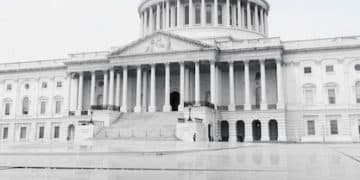The Economic Costs of War: A US Taxpayer’s Perspective

The economic costs of war, viewed from a United States taxpayer’s perspective, encompass not only direct military expenditures but also long-term effects like increased national debt, healthcare costs for veterans, and indirect impacts on economic sectors.
The true cost of conflict extends far beyond the battlefield. For US taxpayers, understanding the economic costs of war: a US taxpayer’s perspective is crucial for informed civic engagement.
Understanding the Direct Costs of War
The initial and most obvious economic impact of war is the surge in government spending. Taxpayer dollars are funneled directly into military operations, weapons procurement, and personnel costs. But how significant are these direct costs?
Military Spending Breakdown
Understanding where taxpayer money goes in wartime is key. Military spending isn’t just about bullets and tanks; it’s a complex web of resource allocation.
- Increased procurement of military equipment: From advanced aircraft to basic supplies, the demand skyrockets.
- Personnel costs: Salaries, benefits, and hazard pay for active-duty military personnel surge during wartime.
- Operational and maintenance expenses: Fuel, transportation, and upkeep of military assets contribute significantly.
- Research and development: Investment in new military technologies spikes as nations seek a tactical advantage.
These direct expenditures represent a significant reallocation of resources, often diverting funds from domestic programs and infrastructure projects. The immediate impact is a strain on the federal budget, which often leads to increased borrowing and national debt.

In conclusion, the direct costs of war, while initially apparent, have a long ripple effect on the US economy. By understanding these direct costs, taxpayers can better assess the true financial burden of military engagements.
The Ripple Effect: Indirect Economic Consequences
Beyond the immediate expenses, war casts a long shadow of indirect economic consequences. These impacts may be less visible but can significantly affect the US economy and the financial well-being of its citizens.
Healthcare Costs for Veterans
The long-term healthcare needs of veterans represent a substantial financial commitment. Providing medical care, mental health services, and disability benefits to those who served comes at a significant cost.
Veterans often face physical and mental health challenges stemming from their service. These can require ongoing treatment and support, placing a burden on the Department of Veterans Affairs (VA) and, ultimately, on taxpayers.
Impact on National Debt
Wars are often financed through borrowing, leading to an increase in the national debt. Servicing this debt places a long-term burden on taxpayers, diverting resources from other essential government functions. Deficit spending to fund military operations increases the overall debt, which can constrain future economic growth. High debt levels can also lead to higher interest rates, further exacerbating the financial burden on taxpayers.
In conclusion, these indirect costs represent a substantial but often overlooked component of the economic impact of war. Understanding these consequences is crucial for a complete picture of the financial burden on US taxpayers.
The Opportunity Cost: What Else Could That Money Fund?
Every dollar spent on war is a dollar that could have been invested elsewhere. Understanding the opportunity cost helps taxpayers evaluate the trade-offs involved in military spending.
Education and Infrastructure
Investment in education and infrastructure are essential for long-term economic growth. Diverting funds to military operations can hinder these critical sectors. Resources that could have modernized highways, improved schools, or funded research are instead directed towards military endeavors.
Consider the potential benefits of investing in renewable energy, healthcare research, or early childhood education. These investments could yield significant returns in terms of job creation, improved health outcomes, and a more skilled workforce.
Social Programs and Healthcare
Funding for social programs and healthcare initiatives often competes with military spending. Taxpayers must consider the trade-offs between national security and social welfare. Resources diverted to military operations could have been used to expand access to healthcare, reduce poverty, or provide job training programs.

In conclusion, understanding the opportunity costs of war provides a broader perspective on the true economic burden on US taxpayers. By considering alternative uses for these funds, taxpayers can foster a more informed dialogue about budgetary priorities and their impact on society and the economy.
Analyzing the Impact on Different Economic Sectors
The economic impact of war is not uniform; different sectors experience varying effects. Understanding these sector-specific impacts helps taxpayers appreciate the complexity of war’s economic consequences. While some sectors may benefit in the short term, others face significant challenges.
Defense Industry Boom
The defense industry often experiences a surge in demand during wartime. Companies that manufacture weapons, equipment, and military technology see increased contracts and profits. This can lead to job creation and economic growth in specific regions. However, this growth is often temporary and unsustainable, dependent on continued military engagement, and can create economic disparities.
Civilian Sector Challenges
While the defense industry may thrive, other sectors often face challenges. Increased military spending can divert resources from civilian research and development, infrastructure, and social programs. This can hinder innovation, reduce productivity, and slow overall economic growth.
- Reduced investment in renewable energy and technology
- Decreased funding for infrastructure projects
- Cutbacks in social programs like education and healthcare
These challenges are compounded by the increased national debt, which can lead to higher interest rates and reduced investment in productive assets, creating trade imbalances, and eroding consumer confidence.
In conclusion, assessing the impact on different economic sectors provides a more nuanced understanding of war’s economic consequences. Taxpayers should consider both the immediate benefits and long-term costs associated with military spending and its impact on various industries.
The True Cost: Accounting for Long-Term Obligations
The economic impact of war extends far beyond the immediate conflict and its direct financial expenditures. Understanding the true cost requires accounting for long-term obligations and commitments. Pensions are just one example.
Veterans’ Benefits and Pensions
Providing veterans’ benefits and pensions represents a significant long-term financial obligation. These costs can continue for decades after a conflict ends, placing a strain on future budgets. While the financial benefits are important, the allocation of taxpayer money for this objective can cause economic disparities.
- Increased disability payments to compensate for an injury
- Medical expense coverage for veteran’s care through the Veterans Association (VA)
- Monthly pension payments
These are just some of the long-term costs needed to compensate those injured in service. And providing for veteran survivors is also a key long-term obligation.
Social Security and Healthcare
Entitlement programs like Social Security and Medicare already face long-term funding challenges. War-related debt and increased healthcare costs can exacerbate these problems. As debt continues to accumulate, taxpayer money goes to paying off interest. That means less support for Social Security and healthcare.
In conclusion, accounting for long-term obligations is essential for understanding the true economic cost of war. Taxpayers must consider the lasting financial impact on veterans, entitlement programs, and future generations.
What Can US Taxpayers Do? Promoting Fiscal Responsibility
Promoting fiscal responsibility and engaging in informed dialogue are essential steps to mitigate the economic burden of war. Through advocacy, engagement, and research, taxpayers can work to help alleviate the economic costs.
Advocating for Transparency
Transparency in government spending is crucial for accountability. Taxpayers have the right to know how their money is being spent, especially in times of conflict. Demanding detailed reporting on military expenditures and advocating for independent audits can help ensure responsible use of taxpayer dollars. More accurate government financial reports would allow for more public discourse and citizen-initiated solutions.
Engaging in Informed Dialogue
Engaging in informed dialogue about budgetary priorities and the economic impact of war is essential for a healthy democracy. Taxpayers should educate themselves on the issues and participate in discussions. Educated citizens can then advocate for the economic best interests of the collective taxpayer community.
- Researching the facts of any given economic situation or conflict
- Discussing the implications with local representatives
- Encouraging others to also become informed and take action
Creating an environment of open discussion can help prioritize spending in a constructive way.
In conclusion, promoting fiscal responsibility and engaging in informed dialogue are key steps for US taxpayers concerned about the economic costs of war. By advocating for transparency and participating in discussions, citizens can foster better government actions.
| Key Point | Brief Description |
|---|---|
| 💸 Direct Costs | Immediate military expenditures. |
| 🏥 Veteran Care | Long-term healthcare costs for veterans. |
| 🏛️ Opportunity Cost | Funds diverted from other vital social programs. |
| ⚖️ Fiscal Responsibility | Promoting transparency. |
Frequently Asked Questions
▼
Direct costs include military spending on personnel, equipment, and operations. Increased government spending results in strained budgets and a growing national debt.
▼
Wars are often financed through borrowing, leading to increased national debt. Servicing this debt place a long-term burden on taxpayers, diverting resources.
▼
Opportunity costs refer to the alternative uses of resources spent on war, hindering investment in education, infrastructure, and critical social programs.
▼
Veterans often require extensive physical and mental healthcare, which requires the allocation of taxpayer dollars for VA programs and facilities.
▼
Taxpayers can advocate for transparency in government spending, participate in informed dialogue, and support responsible use of taxpayer dollars.
Conclusion
Understanding the economic costs of war from a US taxpayer’s perspective involves considering the direct expenditures, indirect consequences, opportunity costs, and long-term obligations. By engaging in informed dialogue and promoting fiscal responsibility, taxpayers can play a role in shaping budgetary priorities and mitigating the economic burden of war.





